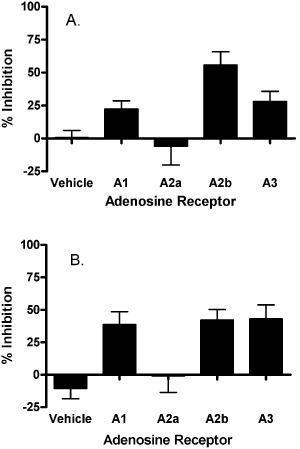149P Brighton
Winter Meeting December 2008 |
Pharmacological characterisation of the adenosine receptor involved in the activation of rat and guinea pig vagal sensory nerves
Megan Grace1, Mark Birrell1, Lorna Ewart2, Duncan Armstrong2, Maria Belivisi1
1Imperial College London, UK; 2AstraZeneca, Alderley Park, Cheshire, UK
Adenosine is produced endogenously via the breakdown of adenosine triphosphate, and is commonly used to treat cardiovascular diseases because it interacts with the A1 receptor to decrease heart rate and cardiac contractility, and the A2 receptors to induce vasodilatation (Bruns 1990). However, patients often experience side-effects such as dyspnoea and chest discomfort when treated with adenosine, which are thought to be due to airway sensory nerve stimulation. Although adenosine has been shown to cause bronchoconstriction and activate vagal sensory nerves (Thorne & Broadley 1994; Hong et al, 1998; Chyachoo et al, 2006), no one has as yet fully characterised which of the four receptor subtypes (A1, A2a, A2b and A3) adenosine interacts with to activate sensory nerves. The aim of this study was to pharmacologically profile adenosine receptors on sensory vagal afferents on the guinea pig (Male Dunkin-Hartley, 300-500g) and rat (Male Wistar, 300-400g) isolated vagus nerve preparation.
Adenosine reproducibly stimulated the guinea pig and rat vagus nerves in a concentration-dependent manner, inducing maximum depolarisation with a 10 mM dose (0.066 ± 0.009 mV guinea pig; 0.075 ± 0.011 mV rat). Human vagus (Male donor tissue from lung transplant surgery surplus to clinical requirement) was also shown to respond to adenosine (3 mM) with comparable depolarisation (0.08 mV) to that of the guinea pig and rat vagi. Perfusion of the vagus nerves for 10 min with 3 μM of a selective A1 (DPCPX) A2b (MRS1706) or A3 (MRS1220) receptor antagonist partially blocked sub-maximal (3 mM) adenosine-induced responses; whereas, incubation with a selective A2a (SCH58261) receptor antagonist did not appear to influence adenosine-induced stimulation (Figure 1).
In conclusion, adenosine induces small but reproducible depolarisations of the guinea pig and rat vagus nerves, apparently via the A1, A2b and A3 (but not A2a) receptors. As stimulation of the vagal sensory nerves is associated with dyspnea one may suggest that the side effects of adenosine treatment could be through these receptors.

Figure 1. Inhibition of 3mM adenosine-induced stimulation by 3 μM selective adenosine receptor antagonists on the a) guinea pig and b) rat vagi (n=4-6).
Bruns (1990). Annals NY Acad Sci, 603, p211-225
Chyachoo et al. (2006). J Physiol, 575, p481-490
Hong et al. (1998). Journal of Physiology, 508, p109-118
Thorne & Broadley (1994). Am J Respir Crit Care Med, 149, p392-399
|


